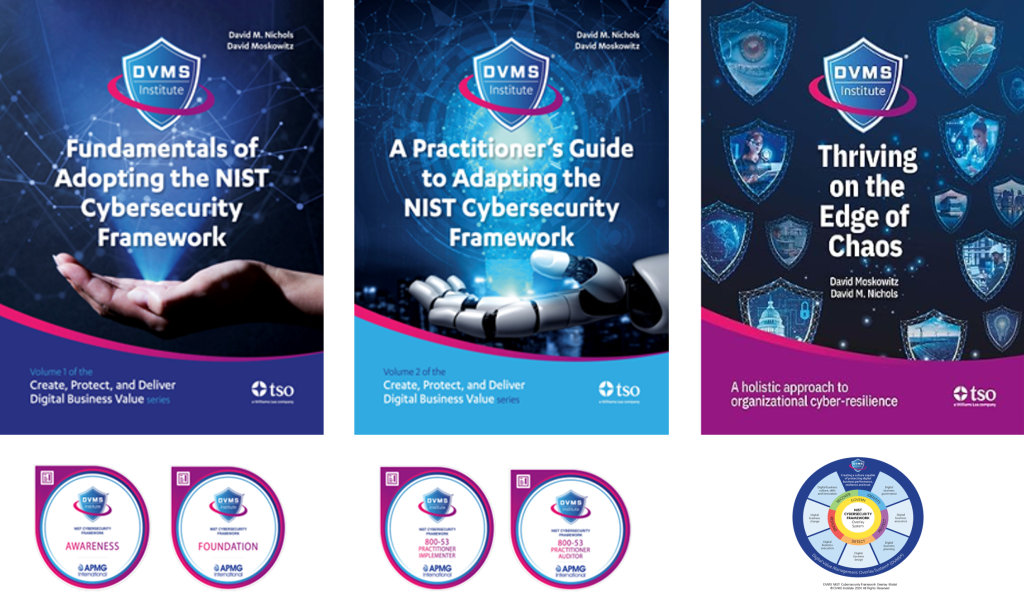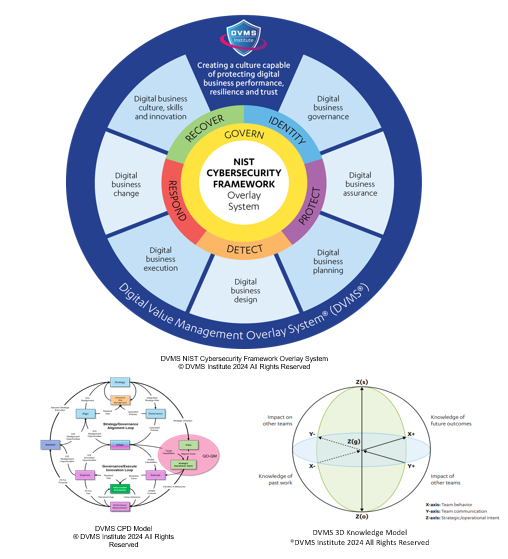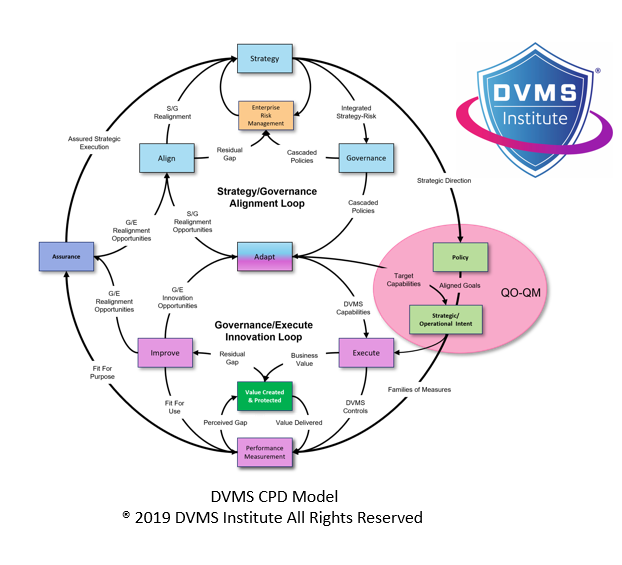Eight Reasons Why Every Business Needs A Digital Value Management System® (DVMS)
Rick Lemieux – Co-Founder and Chief Product Officer of the DVMS Institute
Introduction: ITSM, GRC, and Cybersecurity Reimagined
Cyber resilience has become a strategic imperative in today’s rapidly evolving digital world. It is no longer enough for organizations to merely defend against threats—they must build adaptive capacity to recover, learn, and grow stronger through adversity. The Digital Value Management System® (DVMS) presents a groundbreaking approach to achieving this objective. More than a framework or a methodology, DVMS is a scalable overlay designed to integrate seamlessly with existing organizational systems to enable the concurrent creation and protection of digital business value. By embedding ITSM, GRC, and cybersecurity into enterprise strategy, risk management, culture, and operational execution, DVMS offers a comprehensive, proactive model for organizational resilience in a volatile, uncertain, complex, and ambiguous (VUCA) world.
1. From Cybersecurity to Cyber Resilience: A Paradigm Shift
Traditional ITSM, GRC and cybersecurity strategies often treat risk as an isolated IT concern, resulting in fragmented defenses and reactive tactics. In contrast, the DVMS approach is rooted in systems thinking and recognizes ITSM, GRC and cybersecurity as a business problem, not just a technical one. It reframes ITSM, GRC and cybersecurity as “strategy-risk,” a concept where value creation and protection are inseparable and concurrent activities. This integrated mindset enables organizations to proactively identify, prioritize, and mitigate risks in alignment with strategic objectives.
2. The DVMS Overlay: Scalable, Adaptable, and Actionable
The DVMS is not a one-size-fits-all solution; it is designed to be adaptable to all. Its power lies in its structure as an overlay—a system that encompasses and enhances what an organization already does, regardless of its frameworks, methods, or size. The overlay provides a systems-based structure of seven minimum viable capabilities: Govern, Assure, Plan, Design, Change, Execute, and Innovate. These capabilities ensure that risk management is embedded throughout the organization’s lifecycle, from strategic planning to operational execution.
3. Integration with the NIST Cybersecurity Framework (CSF) 2.0
The DVMS is uniquely positioned to operationalize the NIST Cybersecurity Framework (CSF) 2.0, which defines cybersecurity outcomes under six core functions: Govern, Identify, Protect, Detect, Respond, and Recover. While the CSF articulates the “what” of cybersecurity, the DVMS provides the “how.” It enables organizations to create Organizational Profiles, align with CSF Tiers, and apply informed references contextually and meaningfully. In this sense, the DVMS is a practical bridge between the CSF’s high-level guidance and the detailed execution of cyber risk management.
4. Cultural Transformation and Leadership Accountability
A core strength of the DVMS lies in its emphasis on culture and leadership. Cyber resilience is not achieved through tools alone; it is a function of how people behave, make decisions, and learn from adversity. The DVMS recognizes that organizational culture is the expression of structure and behavior, and that meaningful change requires leadership to model accountability, foster transparency, and promote a questioning mindset. By embedding a culture of continuous learning and cross-functional collaboration, the DVMS enables organizations to become adaptive and resilient learning organizations.
5. Practical Implementation through the DVMS CPD, MVC-ZX and FastTrack Models
The Create-Protect-Deliver (CPD) Model at the heart of the DVMS provides a practical mechanism to synchronize digital value creation and protection. The CPD Model, powered by the MVC-ZX model minimum viable digital business capabilities (Govern, Assure, Plan, Design, Execute, Change, and Innovate) emphasizes the importance of understanding work as a system, integrating strategy-risk with execution, and ensuring that feedback loops enable continuous improvement. The DVMS FastTrack™ approach further accelerates implementation through a phased, agile path—from basic hygiene to continual innovation—allowing organizations to make measurable progress toward resilience without being overwhelmed.
6. Enabling Knowledge, Culture and Strategy Operational Alignment through the DVMS 3D Knowledge Model
The 3D Knowledge Model fits within the broader DVMS ecosystem as a dynamic decision-support tool that enables organizations to visualize and coordinate how knowledge, collaboration, and strategic alignment interact across teams and time. Functioning as an integral layer of the DVMS overlay, the 3D Knowledge Model (with its X-axis for past-current-future knowledge, Y-axis for team collaboration, and Z-axis for strategic-operational alignment) helps translate the abstract notion of “seeing the whole, not the hole” into practical, actionable insight.
The 3D Knowledge Model ensures that cybersecurity efforts—such as those guided by the NIST CSF 2.0—are embedded within a culture of continuous learning, strategic risk thinking, and proactive behavior, enabling organizations to uncover hidden vulnerabilities, challenge assumptions, and foster resilience as an outcome. The model supports both the CPD Model and the DVMS Z-X Model by providing a cognitive framework for evaluating team behaviors and decision-making in complex adaptive systems.
7. Decision Support through Metrics and Mental Models
The DVMS integrates structured decision-making tools like the Goal-Question-Metric (GQM) and Question Outcome–Question Metric (QO-QM) models to make cyber resilience tangible. These tools guide organizations in asking better questions, measuring what matters, and validating assumptions. This systems-based approach replaces arbitrary controls with evidence-based, outcomes-driven action plans, improving accountability and performance assurance.
8. Enabling Value Creation in Complex Environments
In complex adaptive systems—such as modern digital enterprises—the DVMS excels by embracing change rather than resisting it. It helps organizations navigate complexity by aligning structure and behavior, enabling innovation while maintaining control. Through its layered structure and cultural adaptability, DVMS supports risk-informed decision-making at all levels, ensuring that security is not an afterthought but an integral part of delivering value.
Conclusion: DVMS as a Strategic Imperative
In an age where cyber threats are a constant and complexity is the norm, the DVMS stands out as the best solution for enabling cyber resilience. It does so not by offering a new framework to adopt, but by helping organizations see and think differently. It turns ITSM, GRC, and cybersecurity from a defensive tactic into a strategic enabler of performance, resilience, trust, compliance, and value. As organizations embrace the DVMS, they position themselves to survive in the digital era and thrive on the edge of chaos.
About the Author

Rick Lemieux
Co-Founder and Chief Product Officer of the DVMS Institute
Rick has 40+ years of passion and experience creating solutions to give organizations a competitive edge in their service markets. In 2015, Rick was identified as one of the top five IT Entrepreneurs in the State of Rhode Island by the TECH 10 awards for developing innovative training and mentoring solutions for boards, senior executives, and operational stakeholders.
Traditional siloed approaches to ITSM, GRC, and Cybersecurity are no longer sufficient to manage modern digital supply chain complexity, dependencies, and disruptions.
The DVMS Institute Certified Training Courses teach organizations the skills to unite existing ITSM, GRC, and cybersecurity programs into an integrated Digital Value Management System® (DVMS) that ensures resilient, compliant, and trusted digital operations.
The DVMS MVC, CPD, and 3D Knowledge models seamlessly align digital Strategy, Governance, Operations, and Culture into an integrated overlay system that drives adaptive governance, operational resilience, and performance assurance across complex digital supply chains.
The DVMS makes existing ITSM, GRC, and Cybersecurity investments work better together. By adopting a DVMS, organizations are positioned to:
- Maintain Operational Stability Amidst Constant Digital Disruption
- Deliver Digital Value and Trust Across A Digital Ecosystem
- Satisfy Critical Regulatory and Certification Requirements
- Leverage Cyber Resilience as a Competitive Advantage

DVMS Explainer Videos
- Architecture Video: David Moskowitz explains the DVMS System
- Case Study Video: Dr. Joseph Baugh Shares His DVMS Story.
- Overlay Model – What is an Overlay Model
- MVC ZX Model – Powers the CPD
- CPD Model – Powers DVMS Operations
- 3D Knowledge Model – Powers the DVMS Culture
- FastTrack Model – Enables A Phased DVMS Adoption
Digital Value Management System® is a registered trademark of the DVMS Institute LLC.
® DVMS Institute 2025 All Rights Reserved




